A journey through the India that time forgot
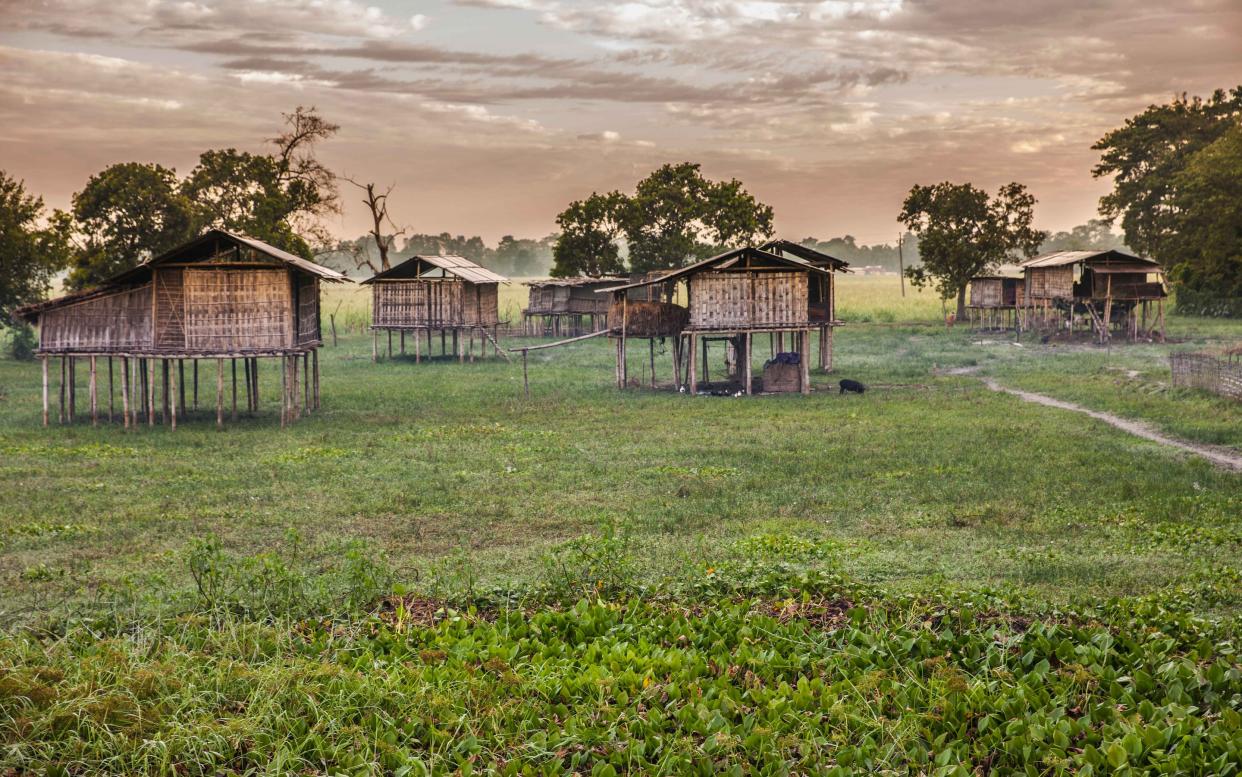
Here’s a good quiz question. What’s the collective noun for a group of rhinocerus? Answer: a “crash” or “stubbornness”, and that’s a pretty accurate description of my most recent encounter with a rhino in the Kaziranga National Park in north-east India.
This particular rhino, injured from a spat with another male, emerged briskly from a path through high grassland and squared up to our jeep with the look of an angry male driver who was not going to budge.
So our guide did the decent thing and reversed at speed, only to round another bend to find a pair of mating rhinos just ahead on the path. We watched in awed silence as the animals carried on regardless for 10 minutes before trotting off into the long grass.
“That could have been tricky,” said our guide. “Rhinos take up to three hours to mate. The other day a pair blocked a main track for about 90 minutes.”
Kaziranga, a Unesco World Heritage site in the Indian province of Assam, is among the best places in the world to see one-horned rhino, along with more reclusive tigers and a host of noisy birdlife. Safaris there are highlights of a cruise along the Brahmaputra, one of the great rivers of India that rises in the Tibetan Himalayas and winds across Assam before dropping down through Bangladesh into the Bay of Bengal.
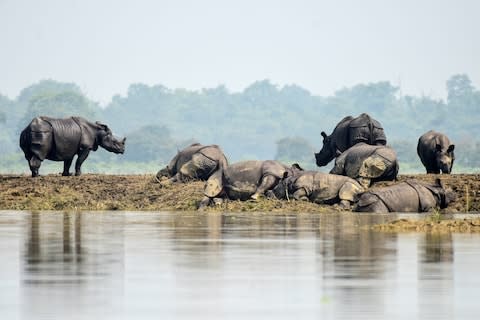
We’d gone ashore early to see the park on elephant back, swaying across grassy plains in the pale light before sunrise, several baby elephants in tow sticking close to their mothers. Herds of endangered swamp deer lifted their heads to glance at us briefly, wild boar bustled busily past and rhino peered myopically from boggy clearings.
Then, switching from elephant to jeep (much easier on the hips) we wound slowly through wooded areas of teak and acacia, orchids sprouting extravagantly from almost every tree. Tigers were in short supply, but we spotted a crested serpent eagle, and a pair of hornbills with magnificent double-decker beaks landed heavily in a tree above us.
Wildlife and nature are very much the theme of Brahmaputra cruises, along with visits to some of the small, remote communities along the river bank. But before flying up to Assam our group had a noisy, exhilarating burst of urban India with three nights in Kolkata, formerly Calcutta.

The capital of British India until 1911, Kolkata still bears traces of its colonial past in the Royal Calcutta Turf Club and the countless statues of Queen Victoria. At times we might have been in a busier, grimier, gently crumbling Kensington, amid gothic and neo-classical facades, pillars and colonnades, turrets and domes and ornately plastered mansion blocks. At the grand marble Victoria Memorial, a Raj version of the Taj Mahal with a rather unsettling Italianate dome, Indian families wandered among the water channels and flowers, the women’s saris as bright as the beds of dahlias and marigolds.
Local guides whisked us around the city in buses, taking in the main sites including the rambling flower market above the River Ganges where giant bags of dahlia heads or mango leaves spilled onto the pavement and stalls were festooned with temple garlands.
At South Park cemetery, built in the 1700s for pioneers of the East India Company, we found a wonderfully perplexing memorial plaque among the towering trees and creepers. “Here was deposited” records a newly restored tablet “the mortal part of a man who feared cod but not death.” The restorer’s error gently cocked a snook at the grandiose epitaphs on mossy obelisks and mausoleums, recording the fortitude, rectitude, manliness and unquestioning authority of those whose tombs are gradually succumbing to tree roots and time.
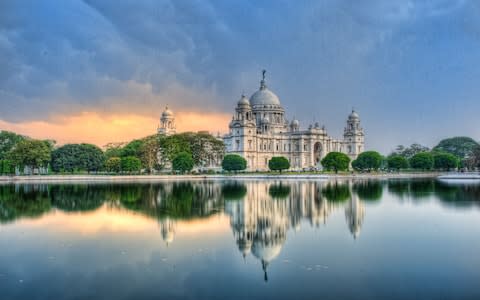
There were more memorials, including one to the Black Hole of Calcutta, at lovely St John’s church, modelled on St Martin-in-the-Fields. Here, instead of the roar of London traffic, sunlight, birdsong and tropical warmth streamed through the open windows.
But fascinating as the city was, after three days we were all ready for the Brahmaputra and the rural landscape of Assam. This was late February, when the river is at its lowest, and our little ship, the MV Mahabaahu, followed a sinuous course upriver from the town of Guwahati, led by a pilot boat to navigate the shifting sandbars. We were travelling with the tour operator Noble Caledonia, which had chartered Mahabaahu for this cruise, and our 42 fellow passengers were mostly British with a handful of delightful Australians and a Russian couple. Aged from early sixties to early eighties, they were a well-travelled, up-for-anything crowd. Brexit discussions were neatly sidestepped and a great camaraderie developed over the week-long journey.
The ship was comfortable, full of character and spotlessly clean. En-suite wood-panelled cabins had picture windows or small balconies, the open top deck had plenty of chairs, sun loungers and binoculars, there was a small outdoor pool and spa, a comfortable lounge and an airy dining room with a choice between an Indian or a western menu. But it was the crew – universally charming, efficient and helpful – who made the cruise special and felt, by the end of the trip, like friends.
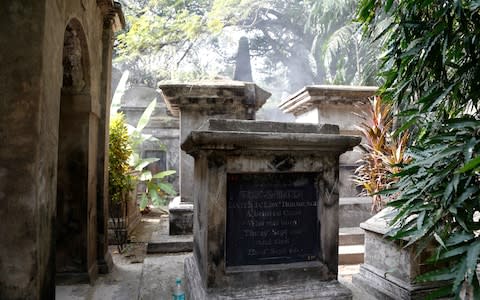
As for the river, it felt as wide as an inland sea (figures vary, but up to six miles across in places). As we slipped among the sandbank islands, some topped with grass, trees and the odd hut, some steppe-like, scattered with bleached driftwood, it was extraordinarily peaceful with just the odd fishing boat or wild water buffalo to share the scene. Occasionally we’d go through a small village where people gathered to watch us pass, standing motionless on the distant bank like statues. Or a call would go out from one of the crew as they spotted dolphins or kingfishers by the ship.
Shore visits (usually two a day) were preceded by a talk from the ship’s excellent naturalist cum historian, cum cultural advisor. So we were well genned up when we went ashore on the first full day, via a rather wobbly gangplank (the crew formed a human handrail) to visit a village of the Bangla people, displaced refugees from Bangladesh who settled by the river on unclaimed land.
At first we felt like first-world interlopers as we trooped past small fields of aubergines, chillies, lentils and potatoes, followed by an inquisitive posse of goats and small boys on huge bikes. We must have seemed an odd-looking bunch, but the villagers greeted us with good humour, showing us their school, shrine and crops, while one of the crew acted as translator. The Mahabaahu is one of only a handful of small cruise ships to ply this stretch of river, so tourists are still relatively rare here, and everywhere we went we were asked to pose for photographs – like an exotic alien species.
Other shore visits took us to an Assamese silk-weaving village from where we returned with armfuls of shawls and scarves, a jute factory (like a scene from King Cotton), two tea plantations and a village of the tribal Mishing people (more engaging children, more armfuls of skilfully woven textiles). On Majuli, the world’s largest river island, we went ashore to watch spectacular dancing, and at Sivasagar we wandered around majestic stupa-like temples and the ruined palace of the Ahom dynasty, rulers of this region for nearly 600 years.
All the trips were cleverly thought out, giving us glimpses of a part of India that few foreign tourists see. But the real star of the cruise was the river itself. Exploring the shores of Kaziranga National Park in the ship’s tenders, we spotted otters dipping and diving and pelicans flapping lazily overhead. Rhesus monkeys chattered in flame-of-the-forest trees, little turtles sunned themselves on half-submerged branches, and a male water buffalo peered at us from under its huge horns.
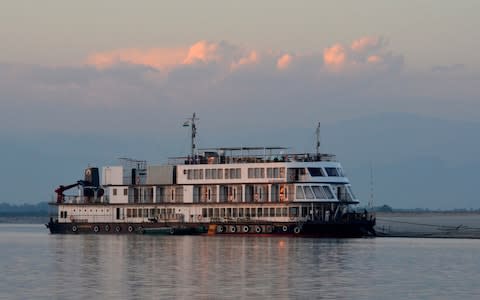
We grew to love the space, the emptiness, the vastness of the river landscape. Going ashore for drinks on a deserted island one evening, we lit candles and sent them floating down the river in clay pots. Mirroring the star-filled sky above, the chain of lights drifted magically to the dark horizon. There was nothing around for miles, and it felt as though we’d slipped back a thousand years.
A cruise along the Brahmaputra, I realised, is more than a view of rural Assam. It’s a brief respite from the hubbub of the modern world.
How to do it
A 12-night Assam & the Mighty Brahmaputra cruise with Noble Caledonia from £4,295pp departing January 6, February 3 and November 10, 2021, including four nights at Oberoi Grand hotel in Kolkata, seven nights on MV Mahabaahu and return flights (020 7752 0000; noble-caledonia.co.uk).


